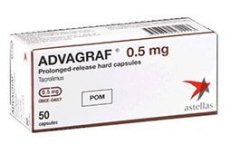Medical expert of the article
New publications
Preparations
Advagraf
Last reviewed: 03.07.2025

All iLive content is medically reviewed or fact checked to ensure as much factual accuracy as possible.
We have strict sourcing guidelines and only link to reputable media sites, academic research institutions and, whenever possible, medically peer reviewed studies. Note that the numbers in parentheses ([1], [2], etc.) are clickable links to these studies.
If you feel that any of our content is inaccurate, out-of-date, or otherwise questionable, please select it and press Ctrl + Enter.

Advagraf belongs to the pharmacotherapeutic group of immunosuppressants (immunosuppressants), which are used to artificially suppress the immune system. International nonproprietary name: Tacrolimus. Manufacturer: Astellas Pharma Europe BV (Netherlands), Astellas Ireland Co. Ltd. (Ireland).
Other trade names: Tacrolimus, Tacrolimus-Teva, Prograf, Fujimycin.
Indications Advagrafa
Pharmacodynamics
The pharmacological action of Advagraf is provided by the active substance of the drug tacrolimus - a natural macrolide macrolactam ascomycin (tacrolimus), produced by the actinobacterium Streptomyces tsukubaensis.
The body's rejection of the transplanted organ or tissue is stopped by suppressing the T-cell response against foreign HLA antigens, as well as by blocking the pathways for transmitting T-cell signals through calcium channels.
Tacrolimus binds to the cytosolic protein of T-lymphocyte cells macrophyllin-12 and blocks the enzyme calcineurin (CaN). As a result, the formation of T-cytotoxic lymphocytes and cytokines (in particular, interleukins and gamma-interferon, which stimulate cells of the immune system) is suppressed and the intensity of proliferation of B-lymphocytes, which produce antibodies, is reduced.
 [ 7 ]
[ 7 ]
Pharmacokinetics
After oral administration, the active substance of Advagraf is absorbed in the upper gastrointestinal tract, enters the bloodstream and binds to plasma proteins; the maximum concentration in the blood plasma occurs after approximately two hours.
The bioavailability of the drug is 20-25%; the rate of clearance of tacrolimus from biological fluids of the body ranges from 4 to 6.7 liters per hour (depending on the transplanted organ); the half-life is about 43 hours.
Advagraf is metabolized in the liver and intestines. Metabolites are excreted in bile. No more than 1% of the active substance is eliminated unchanged in urine and feces.
Dosing and administration
Advagraf is intended for oral administration: once a day, 1 hour before meals or 2.5 hours after meals, with water.
Advagraf is used only as prescribed by a physician, who determines the dose of the drug individually. After a kidney or liver transplant, 0.2-0.3 mg per kilogram of body weight is prescribed (once a day), for the prevention of allograft rejection - 0.1-0.2 mg/kg (once a day, in the morning).
While taking Advagraf, you should monitor your blood tacrolimus levels to maintain the required therapeutic concentration of the drug in your body.
Use Advagrafa during pregnancy
The use of Advagraf during pregnancy is not recommended because tacrolimus crosses the placenta and its safety for the fetus has not been fully established.
Contraindications
Contraindications to the use of this drug are individual hypersensitivity to tacrolimus, other drugs of the macrolide group or auxiliary components included in the Advagraf capsules.
 [ 11 ]
[ 11 ]
Side effects Advagrafa
The most common side effects of Advagraf include: headaches and joint pain, nausea, diarrhea, increased blood pressure, tremors, sleep disturbances, kidney dysfunction, increased blood glucose and potassium levels.
Common side effects of Advagraf include dizziness and tinnitus,
Shortness of breath, pharyngitis, cough, rhinitis, abnormal heart rhythms, decreased blood pressure, anemia, impaired peripheral circulation, changes in the blood (leukopenia, thrombocytopenia, leukocytosis), convulsions and paresthesia, ulcers of the oral mucosa, abdominal pain and inflammation of the gastrointestinal tract.
There may also be vomiting, flatulence, constipation, acute renal failure (up to toxic nephropathy) and decreased diuresis, damage to liver cells and gall bladder, itchy skin rashes, hair loss, increased sweating. From the side of the central nervous system, depressive-anxiety states, confusion and various psycho-emotional disorders are observed.
It should also be borne in mind that therapy with immunosuppressant drugs significantly increases the risk of developing malignant neoplasms.
 [ 12 ]
[ 12 ]
Overdose
Advagraf is manifested by headache, tremors of the extremities, nausea and vomiting, urticaria, protein metabolism disorder (increased blood urea nitrogen level). Lethargy may occur.
In case of overdose, symptomatic treatment is carried out - after gastric lavage and administration of adsorbents.
Interactions with other drugs
The concentration of Advagraf in the blood is increased by the simultaneous use of antifungal drugs (fluconazole, ketoconazole, etc.) and macrolide antibiotics.
Corticosteroids, phenobarbital, rifampicin, phenytoin, carbamazepine, metamizole, isoniazid, and St. John's wort-based preparations contribute to a decrease in the therapeutic level of Advagraf in the blood.
The following drugs slow down the biotransformation of Advagraf: lidocaine, mephenytoin, miconazole, quinidine, tamoxifen, ergotamine, gestodene, oleandomycin, cortisone, bromocriptine. Magnesium and aluminum hydroxide, cimetidine, cisapride and metoclopramide increase the time of Advagraf elimination from the body.
The toxic effect of tacrolimus on the kidneys is increased by the simultaneous use of non-steroidal anti-inflammatory drugs and aminoglycosides.
Attention!
To simplify the perception of information, this instruction for use of the drug "Advagraf" translated and presented in a special form on the basis of the official instructions for medical use of the drug. Before use read the annotation that came directly to medicines.
Description provided for informational purposes and is not a guide to self-healing. The need for this drug, the purpose of the treatment regimen, methods and dose of the drug is determined solely by the attending physician. Self-medication is dangerous for your health.

